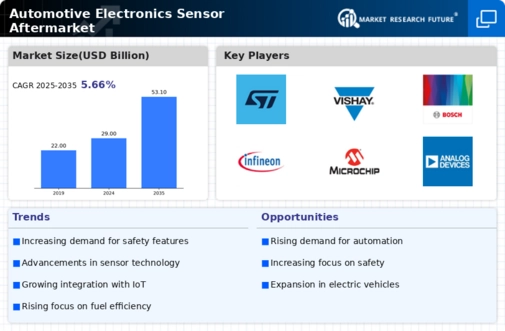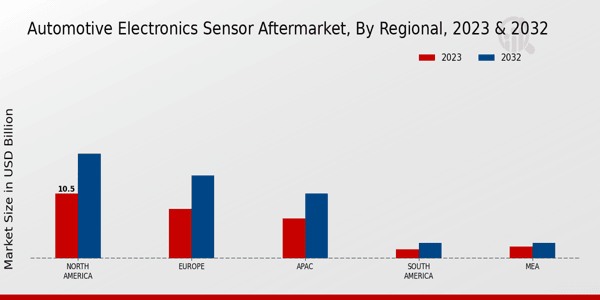Market Growth Projections
The Global Automotive Electronics Sensor Aftermarket Industry is poised for substantial growth, with projections indicating a market size of 29.0 USD Billion in 2024 and an anticipated increase to 53.1 USD Billion by 2035. This growth reflects a CAGR of 5.66% from 2025 to 2035, highlighting the increasing reliance on electronic sensors in modern vehicles. The expansion of this market is driven by various factors, including the rise of electric vehicles, advancements in sensor technology, and the growing demand for safety features. These projections underscore the dynamic nature of the automotive electronics sector and its potential for future development.
Increasing Vehicle Electrification
The trend towards vehicle electrification is a primary driver for the Global Automotive Electronics Sensor Aftermarket Industry. As more manufacturers shift to electric vehicles, the demand for advanced sensors, such as battery management systems and electric motor sensors, is likely to rise. This shift is expected to contribute to the market's growth, with the industry projected to reach 29.0 USD Billion in 2024. The integration of these sensors enhances vehicle performance and efficiency, aligning with global sustainability goals. Consequently, the aftermarket for these components is anticipated to expand significantly, reflecting the evolving landscape of automotive technology.
Growing Focus on Vehicle Connectivity
The emphasis on vehicle connectivity is a significant factor influencing the Global Automotive Electronics Sensor Aftermarket Industry. With the rise of the Internet of Things (IoT), vehicles are increasingly equipped with sensors that facilitate communication between the vehicle and external systems. This connectivity enhances functionalities such as navigation, diagnostics, and remote monitoring. As a result, the aftermarket for these sensors is expected to flourish, driven by the need for upgrades and replacements. The market's expansion is indicative of a broader trend towards smarter, more integrated automotive systems, which are likely to dominate the industry in the coming years.
Technological Advancements in Sensor Technology
Technological advancements in sensor technology are propelling the Global Automotive Electronics Sensor Aftermarket Industry forward. Innovations such as miniaturization, increased accuracy, and enhanced functionalities are leading to the development of more sophisticated sensors. These advancements not only improve vehicle performance but also create opportunities for aftermarket sales as older models require upgrades. The market is projected to reach 53.1 USD Billion by 2035, suggesting a robust growth trajectory driven by continuous innovation. As manufacturers strive to stay competitive, the demand for cutting-edge sensor technology in the aftermarket is expected to rise.
Regulatory Compliance and Environmental Standards
Regulatory compliance and environmental standards are pivotal in shaping the Global Automotive Electronics Sensor Aftermarket Industry. Governments worldwide are implementing stricter emissions regulations, necessitating the use of advanced sensors for monitoring and controlling emissions. This regulatory landscape is likely to drive demand for aftermarket sensors that ensure compliance with these standards. As the industry evolves, manufacturers are compelled to innovate and provide sensors that meet these requirements. The anticipated growth in the aftermarket reflects the increasing importance of sustainability and regulatory adherence in the automotive sector.
Rising Demand for Advanced Driver Assistance Systems (ADAS)
The increasing adoption of Advanced Driver Assistance Systems (ADAS) is shaping the Global Automotive Electronics Sensor Aftermarket Industry. As safety regulations become more stringent, automakers are incorporating a variety of sensors, including radar, lidar, and cameras, to enhance vehicle safety. This trend is expected to drive the aftermarket for these components, as vehicles equipped with ADAS require ongoing maintenance and upgrades. The market is projected to grow at a CAGR of 5.66% from 2025 to 2035, indicating a robust demand for ADAS-related sensors. This growth reflects the industry's commitment to improving road safety and reducing accidents.
























Leave a Comment